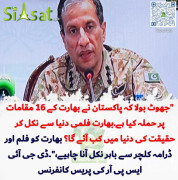So you dont like taxes, i agree with some of what you said but
solution is not to use the bucket to take the water out of the boat,
solution is not to plug the hole,
solution is not to lighten the load.
Solution is to build a better boat.
For long term progress of Pakistan Taxes is what the govt needs to develop the country which creates jobs which generates more taxes, rotates the money back to the people.
It is a well time tested system in all successful economies in the world with a large population.
Most major economies are moving away from the dollar. in the next 50 years Digital currency will take hold. financial Systems developed now will have to be held up for the next 100 years.
You cant think in what needs to be done Now, but what we need to do for 20 40 50 years from now.
A super system of Tax collection will sustain Pakistan economy regardless of what the world economy does.
In short
So you don’t like taxes, i agree with some of what you said but
Question was not whether I like taxes or not, the question was about the reserves of Pakistan and external debt repayment.
For long term progress of Pakistan Taxes is what the govt needs to develop the country which creates jobs which generates more taxes, rotates the money back to the people.
Agreed and also Pakistan has a high recurring fiscal deficit (domestic income less expenditure) as we have been collecting very little taxes and spending beyond our mean, hence, the high domestic/internal debt and liabilities of the country.
Now as to the remaining point you made, to bhai meray economic factors are inter-related, you can’t look at things in isolation. For taxes to rise (a) productivity has to rise (b) tax evasion has to be curtailed.
For productivity to rise we need to import oil, other raw materials and machinery (used to produce many goods in Pakistan). We also need to import other essential items such as medical equipment, drugs, food commodities etc. You need foreign exchange reserves to import. In addition, productivity will rise if we export more (higher the export, more the wealth, more the taxes and employment). Take the example of current textile industry in Pakistan, its exporting more, creating more job opportunities and generating more taxes for the government.
In case of Pakistan, we are already in debt trap. Our foreign currency reserves are low and there is a current account deficit. To repay the loan we are taking new loans. When the current government took over, our external debt was $95.2 Billion, now its $113 billion (despite repayment of $24.5 billion by Pakistan in interest and principal loans during this period). It means we are taking more loans to pay back loans (this has been going on for decades). We are supposed to pay another $28 billion approximately till June 2023 (that’s about $1 Billion a month). From where will we get the foreign exchange to repay our imports and liabilities? More importantly, why are we in such a position? Because our exports have been stagnant for years (around $22 - $24 Billion per year for years), yet imports have been rising.
Year 2008: Export $20.3 Billion, Import $ 42.3 Billion
Year 2009: Export $17.5 Billion, Import $ 37.5 Billion
Year 2010: Export $21.4 Billion, Import $ 31.6 Billion
Year 2011: Export $25.3 Billion, Import $ 43.5 Billion
Year 2012: Export $24.6 Billion, Import $ 43.8 Billion
Year 2013: Export $25.1 Billion, Import $ 43.7 Billion
Year 2014: Export $24.7 Billion, Import $ 47.5 Billion
Year 2015: Export $22.1 Billion, Import $ 43.9 Billion
Year 2016: Export $20.5 Billion, Import $ 46.9 Billion
Year 2017: Export $21.8 Billion, Import $ 57.4 Billion
Year 2018: Export $23.6 Billion, Import $ 60.1 Billion
Fiscal Year 2019: Export $24.3 Billion, Import $ 51.9 Billion
Fiscal Year 2020: Export $22.5 Billion, Import $ 42.41 Billion
What we export in entire year India exports that much in other month. The pace at which India, Bangladesh and China’s exports have increased since 2003, had we followed at the same regional pace, our exports would have been worth more than $65 Billion today (yeah hota tu kitna hota aaj humara external debt, foreign exchange reserve and how much more taxes?)
To finance our imports and debt liabilities we have been borrowing again and again. When you are in such a situation, lenders not only dictate your economic but also political decision making. For example IMF constantly pressurize to remove subsidy on electricity. Our cost of energy is way too high, when we do so, cost of production increases. It causes less business viability, decrease income, unemployment and in turn lesser taxes.
Pressures from Saudi Arabia and UAE on multiple fronts are example of economic and political influence when you are highly indebted.
In short to improve and sustain economy, all economic indicators, current account deficit, fiscal deficit, taxes, unemployment, inflation etc etc has to improve.
Increases taxes and exports both. Hope that settles the matter.
Peace
































